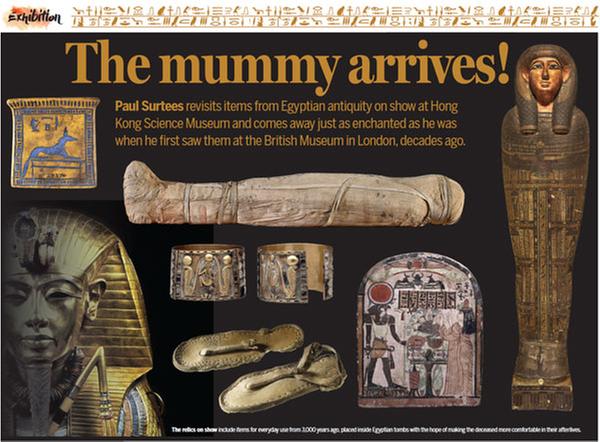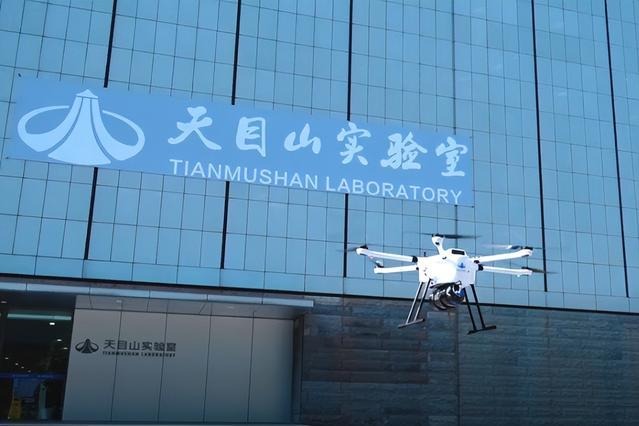The mummy arrives!

Paul Surtees revisits items from Egyptian antiquity on show at Hong Kong Science Museum and comes away just as enchanted as he was when he first saw them at the British Museum in London, decades ago.
Over 200 precious items from ancient Egypt, including six mummies from 3,000 to 1,800 years ago, are now on show at the Hong Kong Science Museum (HKSM). The exhibits have been brought all the way here from London's British Museum (BM) - home to one of the world's best and most extensive collections of Egyptian antiquities. BM curator Marie Vandenbeusch says while some of these mummies on display Hong Kong could previously be viewed at the BM, some others have never been put on public display before, except at their previous outing at the Museum of Applied Arts and Sciences in Sydney, Australia, earlier this year.
Long ago, as a schoolboy in London, I was often taken to visit the vast and varied collections of items from the ancient world in the permanent collection of the BM. I particularly remember being thrilled to view a spectacular visiting exhibition from Cairo of items from the tomb of the boy pharaoh Tutankhamun. Years later I saw some of these interesting tomb objects again at the Egyptian Museum in Cairo. Now Hong Kong people need only travel to Tsim Sha Tsui to see these treasures of Egyptian antiquity, courtesy the generous sponsorship by the Hong Kong Jockey Club Charities Trust.
Called "Eternal Life: Exploring Ancient Egypt", the exhibition is one of the many cultural events mounted to celebrate the 20th anniversary of the establishment of the Hong Kong Special Administrative Region. China and Egypt are two of the world's oldest civilizations. Silk from China would be transported to Egypt via the Silk Route in ancient times. Ivory from Africa was sent the other way. The trading links therefore go back thousands of years. What better way to observe the anniversary of Hong Kong's return to the motherland than by remembering and revisiting historic relics from a culture whose ties with China go back a couple of thousand years?
One of the highlights of the exhibition is a pair of cuff-style bracelets, decorated with beautiful deep blue lapis lazuli stones. This would have been a vastly-expensive material to work with in ancient Egypt, as it was likely transported there all the way from Afghanistan, the only known ancient source of this bright-hued stone.
There's also a wooden toy horse on wheels, about 2,000 years old, which might appeal to very small children. I had a 20th-century plastic version of this same toy as a child - carrying a label, "Made in Hong Kong". A pair of modern-looking leather sandals for young feet, surprisingly well-preserved for their age, might stir mixed emotions in a viewer: They were likely from the grave of an Egyptian child that died in Thebes, at least 3,000 years ago.
The use of modern technologies, such as X-rays and CT scans, enables archeological researchers to look inside mummies without having to risk damage caused while unwrapping the thick layers of linen bandages encasing them. This show intriguingly displays CT scans of the insides of mummies that have still not been unwrapped. HKSM curator Paulina Chan comments that the "Eternal Life" show is in alignment with the museum's goal of popularizing science. She hoped that the show might in fact succeed in giving ideas to visitors from the innovative technology industry in Hong Kong.
Exhibits other than the mummies include statues, steles, jewellery found in the grave (such as a painted pectoral), canopic jars, a funerary boat model and much else besides.
Many of these were found in ancient tombs, intended to support the afterlife of the deceased, which resonates with the traditional Chinese custom of offering food to those who have passed on and burning paper replicas of items of everyday use with the hope of making their spirits more comfortable in the other world. While digging out funerary objects and putting these up for people to view in museums may seem inappropriate to some people, it could be said in defense of the exhibitors that most of these items were separated from the remains of the person they were intended for a very long time ago. Tomb-robbers did their work even in ancient times. Only a few ancient Egyptian tombs were unexposed to the looting and vandalizing and have survived with their contents intact.
Many of the precious tomb offerings ended up in the markets of Western Asia since thousands of years ago. Professional archeological excavators of our own times, however, help to put these in museums across the world. A part of these finds end up in private collections as well. In my opinion, it is probably a better idea to let people appreciate these objects in their original sites, for them to have a better sense of context and history.
HKSM intends to host more than 100 group visits to the show, particularly from the city's schools. It's good to know our younger generations are getting a glimpse of the way Egyptians looked at the business of death and afterlife in ancient times. With luck the show will trigger a similar interest in Chinese antiquities associated with funerary rituals, or even the corresponding period in Chinese history.


(HK Edition 08/04/2017 page14)
Today's Top News
- Evidence mounts of Japan's wartime atrocities
- Gunmen kill 11, wound many on Sydney beach
- Study finds Earth's deep water reservoirs
- China remembers victims of Nanjing Massacre 88 years on
- Philippines' provocations will avail it nothing: China Daily editorial
- China steps up financial support to spur consumption






























